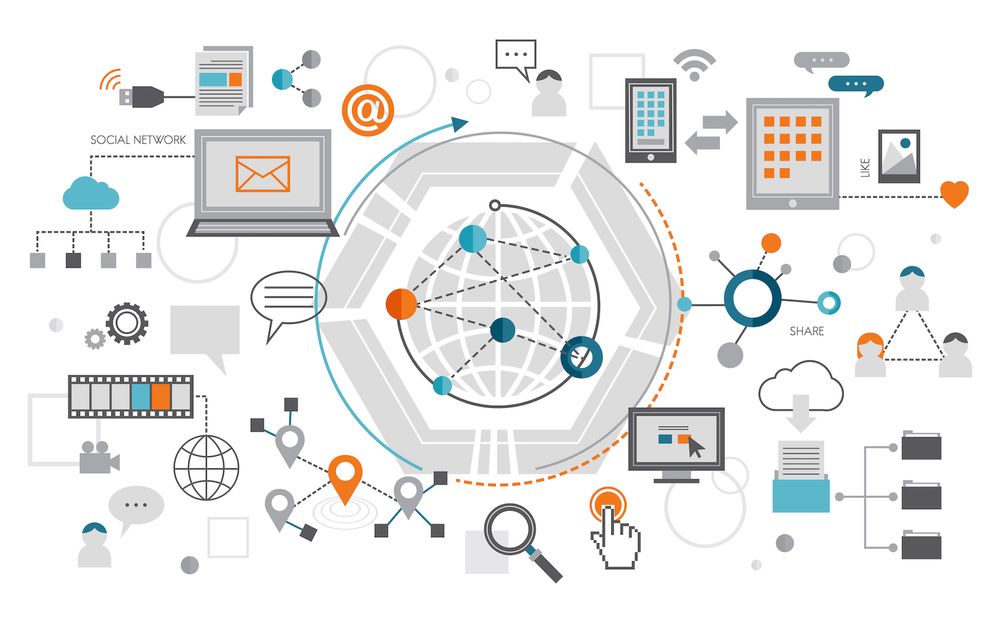Omnichannel Ecommerce: Brick-and-Mortar Not Required
Remote work, Zoom classrooms - these digital experiences are now part of our daily lives. Humanity is now more connected than ever, and now seems to understand the potential of what that means. Doing things online doesn't feel "weird." This is normal. It's the same for retail businesses. The concept of omnichannel e-commerce.
It doesn't require a brick-and-mortar storefront to have a thriving business. If you've got a great concept for a new product or service, all you need is a good attitude and dedication to work, an ability to adapt and a connection to the internet.
What is Omnichannel eCommerce?
Omnichannel Ecommerce is a multi-pronged marketing approach that focuses on providing a seamless customer experience, whether the point of sale is a mobile device, a laptop, or a retailer's physical location. The experience must be uniform across every channel, from your online store to Facebook Marketplace, Amazon, Etsy, and more.
People don't just shop in one location. Also, wherever they're, you should be available.
While the purpose of a selling is to achieve the purpose, you need be aware of what the buyer's journey is when they are attempting to buy. What are the ways you can be participant in that journey?
The Harvard Business Review reports that 73% of all clients use multiple channels throughout the purchase process. This means that when a person is deciding to purchase something there's a solid chance they've done a tremendous amount of research in order to ensure that they're making the best possible purchase.
Does your company not just be the provider of the product your customer is seeking, but also provide the context and details?
Concentrate on the complete customers' experience. It's not only adding something to their shopping cart or complete an order. Instead, you should be asking yourself: How can your business be an online source for information as well as items, goods or services? What can you do to achieve it everywhere you do business on the internet?
The more channels a customer uses, the more valuable they are to your business With an average of 23% more returns purchases and up to 13% more average order value.
Omnichannel eCommerce works.
What is the reason it's important for online stores to utilize channels other than their own websites?
Let's do an experiment. Check out your feed every time you visit your social media account. What kinds of items and shops are displayed to you?
There are probably too many to count. The modern algorithms are so powerful that your feed could bring back things that which you did not realize that you are looking for. Perhaps you're not aware of that time you perused the latest trends in skincare while waiting to be called at the doctor's office however, your feed will. It will let you know who's got the best deals on skincare products right now.
Imagine your business is the aforementioned skincare company. Perhaps you post the link to Facebook to a blog post detailing the best skincare products of 2023. Someone who's interested might click on that link, go through the article, and then go on. But later, they may see an advertisement for your eczema cream, then click to buy it on Amazon. The next time they are looking to purchase something, they go to your website directly and sign up to receive a monthly subscription.
This is three different channels that customers have accessed: Facebook, your website as well as Amazon. They all function to form an efficient omnichannel E-commerce strategy.
Do you find it more difficult to implement an effective omnichannel approach when you don't have a retail location?
No and yes. As we've outlined, the world is online. Therefore, the retail store isn't necessary to provide customers with purchase opportunities at a variety of locations.
There are numerous advantages of having a physical address even though they do come at a fairly hefty cost and commitment.
The point is it's not necessary to feel that the absence of a physical store is a reason to not have an omnichannel focus. If you have a physical location paired with an online shop You shouldn't simply say it's a good day. There are plenty of additional ways to connect with your customers so you're available on the platform of their preference when they're ready to make a purchase.

Benefits of owning an actual retail store
There are many advantages that come with having a physical place. You can, for instance, connect more personally with customers simply by having a space that they can get to know your employees and products.
If your store is at a place that has an abundance of people walking through You can convince people to stop by and make a purchase. The ability to reach out physically who are already in a shopping mentality. They can show products or answer questions right then and there.
Additionally, there's a chance to market your product, for example on-site events or product demonstrations. Hosting an in-person reception is a fantastic opportunity to announce a brand new product.
It has been an option of the numerous options that people can purchase. There are benefits to an actual location, the same way there are benefits to having an online marketplace. The difference is that this avenue comes with some disadvantages as well as costs.
The advantages of being able to not have a physical store
Actually, there are a number of benefits to the absence ofhaving a retail location. There's no expense associated with rent or utilities and there aren't many of the hassles associated with having a physical store. You don't have to deal with the additional staffing and scheduling.
You can narrow your focus and budget to online channels with proven success. Additionally, you'll be nimble so if something changes it is possible to adapt swiftly. Physical locations are a heavy investment and one that you aren't able to pick up or move around on the go.
So, let's go back to our initial answer: yes and no! Retail locations (or lack thereof) can be both advantageous and challenging to your strategy for omnichannel e-commerce. Everything depends on the products you sell and your target audience.
Strategies for an efficient omnichannel strategy
Once you've understood why omnichannel ecommerce is important and necessary, let's take a look at the tips for a successful strategy. This isn't a detailed step-by step outline, but rather guidelines to develop an omnichannel strategy that is the most efficient that you can.
Maintain your brand's image and voice constant across every channel
Imagine a brand that is with a name as well-known as Coca-Cola. If it's a spot on TV that features the polar bears or vending machines in a highway rest area or an advertisement at a diner, its glimmering white and red says one thing: Coca-Cola.
Create a brand voice guide and identity for your business that includes items like specific colors, images, fonts, logos and even a the language. If your company expands and you are faced with a myriad of other things to think about and plan for, your future self will appreciate it.
Be careful when selecting the selling channels
There are a variety of marketing channels that offer various types of targeted audiences. There are many different approaches needed to be successful, but it is important to select the ones which are suitable for your company and commit to giving each the time and attention it deserves.
You should select several to pursue, but don't be reluctant to reject those that truly don't fit your brand or your target market.
Social shopping

Marketplaces
Tapping into a marketplace like Amazon also provides the opportunity to gain access to additional options. Amazon's Fulfillment by Amazon (FBA) will manage all the steps associated with warehouses as well as shipping and the customer with service on orders.
Search
It's likely that you're putting in a significant amount of time on the search engine optimization. In the ideal world when someone is searching for something that you offer then your website and your website is likely to be listed in a flash.
But in reality, people are often conducting much more broad searches and navigating various options for the perfect fit. Google Shopping presents searchers with these options in a way that is simple to read and evaluate.
Check that your site is mobile-friendly
Although every single person, their dog and their dog's pet have smartphones however, an alarming number of websites don't have the luxury of making their sites mobile-friendly.
Seriously. Over 50% of the internet's web traffic comes from mobile.
Imagine not catering to these customers! It's a huge chunk of the internet!
People expect an easy mobile experience on their mobile. Giving them this experience can be the opportunity to leapfrog other competitors and enhance the perception that visitors have of your business.
You'll also want to take the time to review your site across devices of every size: desktops, phones, and tablets. Tools like BrowserStack can help you do this electronically, and without needing users to be physically connected to all sorts of devices.
Be sure images aren't cut off, buttons and links can be easily clicked, navigation menus are easy to navigate, etc. Basically, you want the user experience to be stellar regardless of what gadget users are using in their hand.
Use customer journey mapping
The customer journey map outlines the actions that a customer takes when they interact when they interact with your company or product. It begins with the first time they begin engaging with your brand maybe via an Instagram advertisement, blog post, or an influencer - until they either buy something or decide to stop paying attention.
There are many reasons why the customer journey map is vital to creating an omnichannel strategy for ecommerce. It lets you:
- Get a better understanding of the time, place, and what your customers are doing with your company
- Identify investment opportunities for different marketing points
- Learn about the strengths and weaknesses the purchase process.
- Offer information that will help future market decisions
The mapping of customer journeys also provides the information you need about your customers' preferences, the people who are purchasing your goods, and why they're choosing your company. These details are crucial to continued success and growth in the retail industry and will help you determine your future strategies in omnichannel eCommerce.
Learn to make the customer journey maps.
Offer seamless customer support throughout every channel
Customer service that is efficient is an investment into the future of your business. The ones who have a positive experience write excellent reviews, share their experiences with friends they are happy, and also make purchases repeatedly. In addition, the positive vibe can help keep internal morale high. All of this is part of a longer-term plan to ensure a healthy, happy business.
However, when selling through a variety of platforms, it's challenging to provide high-quality assistance to every client. You'll need to quickly respond to messages, questions, and refund requests on your website, your the selling platforms of third parties such as social media and much more.

Enhance your checkout experience
Customers prefer certain marketplaces or platforms because they're familiar and easy to use. Sometimes it's because they don't need to navigate to an additional web page or an app. Sometimes, it's because their payment options are stored or their checkout procedure is extremely simple.
Creating a valuable omnichannel experience also means allowing the payment methods customers prefer and making the payment process so simple that it is.
You can boost conversions when you check out by doing a few factors:
Organize your email marketing into a single, smart tool
No matter where they purchased an item or found out about your company, if they're on your email list and you follow-up, you'll be able to communicate with your customers. Invite them with welcome emails, reach out to them with deals, and even ask for reviews that can aid in generating additional sales.

MailPoet is a great tool for stores. You can create and modify emails, automate offers based on past purchases, and send abandoned cart emails to recoup lost sales and much more. Like payments, MailPoet brings everything right in your WordPress dashboard. It's a time-saving, ingenious advertising tool via email.
Always review and update your strategy for omnichannel
What are successful companies' traits in the common? They are constantly striving on improving. It's not every platform that is going to work for you. Certain strategies that aren't working for some will provide a significant boost to the person who is using them. Do not be scared of changing and don't get obsessed with particular item.
From there, explore the available data on your platforms and take time to learn about the ways analytics tools function. It's a worthwhile investment for your future.
And remember, long-term growth requires patience. Don't spend too much time looking at other selling. You should be aware of what others are doing successfully and then make your own improvements. Keep revising and improving and you'll go pretty far.
You can go omnichannel with no physical location
An effective omnichannel strategy for e-commerce does not require the presence of a physical store. There's a wide range of other platforms you can offer your products, from your online store and even Amazon, eBay, Etsy, Facebook, Google Shopping and many more.
Make sure you have an unifying presence on each selling channel, connect with your customers, and make sure they feel supported, and put in the marketing work and you'll be in the process of achieving an omnichannel approach to sales!
